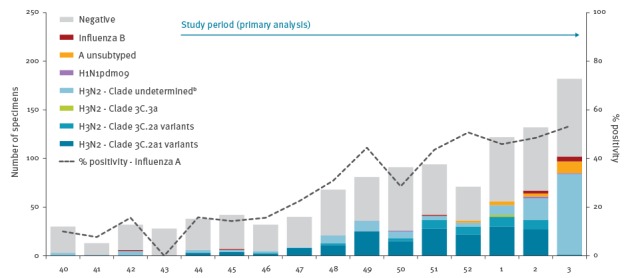Figure 1.
Influenza detections by type/subtype/clade and week of specimen collection, Canadian Sentinel Practitioner Surveillance Network, 2 October 2016–21 January 2017 (n = 1,096)a
a Specimens were included if the patient: (i) met the influenza-like illness case definition (requiring fever and cough and at least one or more of sore throat, arthralgia, myalgia or prostration; fever was not required in elderly patients ≥ 65 years-old), (ii) had specimen collection ≤ 7 days after symptom onset, (iii) was ≥ 1-year-old at the time of onset, and (iv) had valid laboratory RT-PCR results. Specimens are displayed in the epidemic curve regardless of the patient’s vaccination status or timing of vaccination. Missing specimen collection dates were imputed as the date the specimen was received and processed at the provincial laboratory minus two days, the average time between specimen collection date and laboratory received date among specimens with complete information for both values.
b Specimens with undetermined clade included those where sequencing was attempted but failed (n = 42) or sequencing was not attempted, e.g. those with insufficient viral load (n = 8), submitted after the start of the mid-season analysis on 21 January 2017 (n = 99), or excluded from primary vaccine effectiveness (VE) analysis (n=23).

